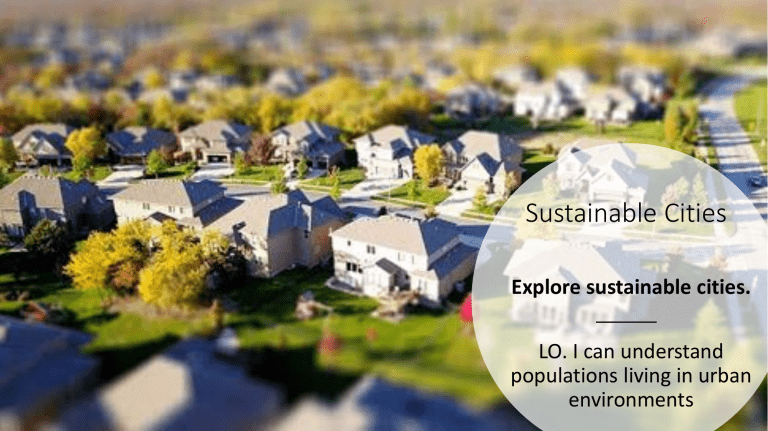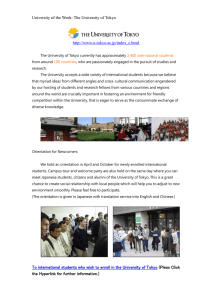
Sustainable Cities Explore sustainable cities. LO. I can understand populations living in urban environments For centuries, cities have been at the heart of the arts and culture, thriving businesses, and innovative ideas. Over ninety percent of urban areas are coastal, which means that most cities on the planet are extremely vulnerable to the effects of the climate crisis as sea levels rise, polar ice melts, and powerful storms sweep across these regions. The sheer number of people who live in cities now and who are expected to move into them in the coming years is startling. Around two-thirds of the world’s population is predicted to live in an urban area by 2050, which means there are also major financial implications when extreme weather like unexpected storms and flooding cause disruptions in businesses and governments. Which city is this? Tokyo is a Mega-City…which means it has a population of over 10 million people. Tokyo has a population of 37.393 million residents. 13.5 million of these people live in the Greater Tokyo area. Why did people first decide to settle there? Look at maps to see what would have been attractive. - Excellent port location makes transportation of goods easy and also makes the city easier to defend. - The land is relatively flat, Tokyo is surrounded by mountainous regions. - Fertile lands from river deposits ensure quality farming land. - Tokyo offers great access to fishing as a sustainable food source, so the residents had good access to fresh, healthy food. - Building materials from the river deposits to make clay for bricks Tokyo is BIG; why live there now? Greater Tokyo is the world's most populous metropolitan area and is the centre of Japanese culture, finance, and government, this also means there are more jobs - There are arts and culture everywhere; even in busy Tokyo, there are shrines and temples everywhere. The religious spots of Shinto and Buddhism, and they are best suited in secluded nature areas - - Public transportation is excellent. Trains and buses are usually the vehicle of choice. Some train lines run every four minutes or less. And the trains go about everywhere. It is also a world economic and industrial centre. - - The city boasts a large number of world-class institutions of higher education notably the highest concentration of universities in Japan - Although the city is so large, it has a very low crime rate and a respected police presence - As well as lots of architecture and tall buildings, the city also has beautiful parks and recreation areas Is this city sustainable? What do we understand by sustainable? Sustainability means that a process, resource or state can be maintained at a certain level for as long as is needed. What does that mean for our cities? We need solutions… The good news is that while cities are particularly at risk from the climate crisis, they are also behind some of the most powerful solutions. That’s why we’re taking a look at three sustainable cities in the world and the steps they’ve taken to become leaders in clean energy and climate solutions. COPENHAGEN, DENMARK Copenhagen is often ranked as one of the greenest cities on the planet. Why? For starters, in 2009 the city set a goal to become the world’s first carbon neutral capital by 2025. Copenhagen has focused on reducing energy consumption in a variety of ways, including using an energy-efficient district heating system that connects to nearly every household and innovative cooling systems that save around 70 percent of the energy compared to traditional air conditioning. Copenhagen has also focused on reducing emissions and improving the health of its residents by improving mobility, integrating transport, and building what’s known as a super cycle highways. Super cycle highways and other bike lanes around the city have led to 45 percent of the city’s residents commuting by bike every day. SAN FRANCISCO, CALIFORNIA It’s no secret that San Francisco and the surrounding Bay Area are a serious techhub and home to some of the most innovative companies in the world, including Salesforce, Airbnb, Uber, and Twitter. Innovations in technologies to improve energy efficiency in buildings and enhance its transportation system make San Francisco a leader in sustainability and clean energy. It’s not uncommon to see hybrid-electric buses driving down the city’s streets. The Bay Area has also cut its water consumption drastically in recent years. As California has battled serious droughts, SINGAPORE With a population of more than five million people, Singapore is one of the most forward-thinking green cities in Asia. The city-state has developed a Sustainable Development Blueprint, which outlines sustainability goals leading up to 2030. The targets include improving energy efficiency by 35 percent, ensuring 80 percent of its buildings are certified green, and having 80 percent of households be within a 10-minute walk to a train station. Singapore has also improved its sustainability by making drastic changes in transportation. The citystate limits car ownership among its residents and has built effective public transportation systems, which has helped reduce pollution and crowding on streets and highways. Think about all of the good things from those cities we have just looked at – what would you use in your planning for a sustainable city? To help you with your task on the next lesson you need to use the internet research guide to investigate what is going on in Sustainable City Planning. Make notes of any ideas that you want to magpie. Plenary questions… How is where you are designing different to where you live now? What would you like to see in future cities? Why?




